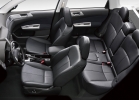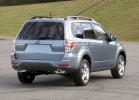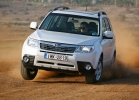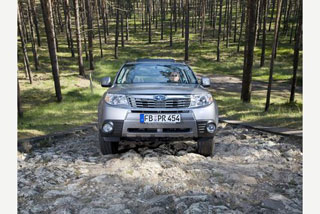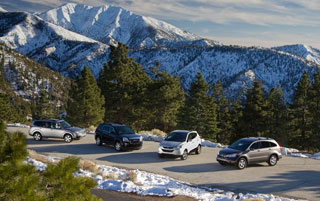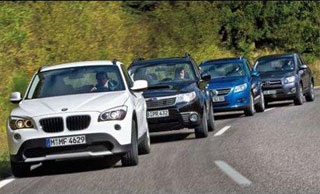Test Drive Subaru Forester since 2008 SUV
AU! Subaru Forester.
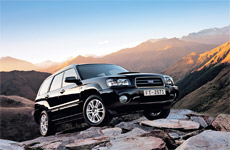 Parentine owners prefer to always rise above the terrain: those who love to look over the roofs of ordinary cars, probably like to live on the top floor. But only after the debut of the Subaru Forester, they were able to fully enjoy their passion to height
Parentine owners prefer to always rise above the terrain: those who love to look over the roofs of ordinary cars, probably like to live on the top floor. But only after the debut of the Subaru Forester, they were able to fully enjoy their passion to height True, there is no such chance with all the owners of Forester, because the car is distributed to the car: his story began without extreme, with the advent of an ordinary Skilometer. But the Japanese already laid the foundation for creating something supernatural: can the relationship with the IMPREZA model? No, friends, can not! As expected, Forester fully inherited the dual character of his passenger fellow. He may be respectful, and a rocket. But regardless of the execution in operation this car is not easy
Forester is diverse. The modification that appeared in 1997 (with the factory index SF), looks calm enough and good-natured. And the car, which came in 2002 and turned out, despite the official status of a new generation car and another SG index, a deeply upgraded version of the model of an old sample, looks more aggressive. However, headlights with squared, safely disappeared during the construction of 2006, still did not turn the boxes in the cigar. After all, with any plumage of Forester a fairly simple five-door wagon. The owners are making a lot of complaints to his body. Let's start with the fact that the carrier frame, and the outer panels are easily bent. In addition, the Japanese clearly saved on noise insulation. Another, it would seem, a small trouble rattling the back door. It rattles the good half of the cars, and the owners had to (and sometimes it is necessary) to apply to eliminate the annoying noise of the smell.
Specifications
Body type Universal
Number of doors 5
Number of places 5
Length 4485 mm
Width 1735 mm
Height 1590 mm
Wheel base 2525 mm
Road clearance 190-210 mm
Suspension type:
Front
rear
Independent, with MacPherson racks
Independent, double-perk
Drive type complete
Brakes:
front
rear
Disk ventilated
Drum (disk)
The volume of gas tank 60 l
Acceleration up to 100 km / h * 11.4 s
Max. speed * 180 km / h
Fuel consumption 100 km:
town
Route *
11.6 L.
6.7 L.
* Data for a car with a motor 2 l and manual transmission.
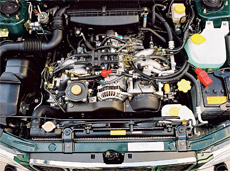 Like the body, Forester's salon is different: until 2002, he was simple as three kopecks, and this also applies to design and finishing materials. After modernization, the inner space acquired a completely modern appearance (however, the plastic was still not the highest sample). However, no matter how it looks like, the interior in any case is quite practical: the ergonomics is not bad, and there is enough compartments for storing small things. That's just on the volume of the volume, the salon drove: the trunk is not enough, and in the back seat is closed. As for the equipment, there are both poorly equipped versions and equipped very rich.
Like the body, Forester's salon is different: until 2002, he was simple as three kopecks, and this also applies to design and finishing materials. After modernization, the inner space acquired a completely modern appearance (however, the plastic was still not the highest sample). However, no matter how it looks like, the interior in any case is quite practical: the ergonomics is not bad, and there is enough compartments for storing small things. That's just on the volume of the volume, the salon drove: the trunk is not enough, and in the back seat is closed. As for the equipment, there are both poorly equipped versions and equipped very rich. Hound qualities are ambiguous: ordinary Forester behave normally itself only in ordinary modes, sports piloting displays them from equilibrium (the steering wheel is not too informative, besides the suspension, let it be clamped, but is distinguished by long strokes). Staten brakes do not cope with their task: more powerful mechanisms are clearly asked here.
We also note that atmospheric engines are not able to endow the car with decent dynamics, although they are not bad at all.
However, everything changes, it is worth finding the wheel of the STI sports modification: here and the reaction is sharper, and the limit possibilities are extensive, and the brakes are more powerful, and the dynamics of water. Among the parkettails, this car is a unique phenomenon: Of course, there are Mitsubishi AirTrek Turbo R and Nissan X-Trail GT, but they appeared much later than Forester Sti. There are, by the way, simpler versions equipped with the same turbo video (for example, S / TB), but this is not entirely STI (more precisely, it's not at all STI): they have brakes are not so powerful, and suspension with a higher road lumen , and the appearance of less aggressive.
As for the engines, SF and SG have a lot of general, but there are many differences. Let's start with similarities. In both machines, the 20th hedgehog (EJ20) with a capacity of 122-137 liters was applied. with. (Late later models, he gives out 158 \u200b\u200bhorses). Both cars meet EJ25, which develops from 156 to 175 liters. with. Turbo motors have enough for the model always, even the European SF can be found a superior engine, though weak, with a capacity of only 170 liters. s., whereas the Japanese returns the same unit to 240-250 liters. with. Depending on whether it leads to the S / TB or STI movement. At the right versions with the SG index, the 2-liter engine is also found, but in
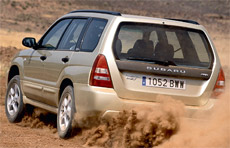 Intermediate: 220 l. with. Sometimes there are Europeans with a much less powerful 177 horses modifying this engine. As for EJ25 with turbocharged, it was installed only under the hood of Forester SG: in the car in the European specification, it issued 211-230 forces, while the same unit of the Japanese with the prefix STI developed 265 liters. with.
Intermediate: 220 l. with. Sometimes there are Europeans with a much less powerful 177 horses modifying this engine. As for EJ25 with turbocharged, it was installed only under the hood of Forester SG: in the car in the European specification, it issued 211-230 forces, while the same unit of the Japanese with the prefix STI developed 265 liters. with. Having understood in the variety of power units, let's talk about their maintenance and repair. So, the regulations set the average interval between that at 15 thousand km (together with the change of engine oil, it is desirable to replace all filters, but if you really don't want to spend money, you can wait until the next maintenance). Replacing the timing belt is based on each seventh, that is, when running 105 thousand km. Cars with turbochargeds should be driven into the service much more often than atmospheric machines (the interservice interval is made to reduce times a half, or even two), since they drive significantly more aggressive than on vegetable modifications. As for the possible unscheduled repair, the most likely candidate for service regulars is atmospheric EJ25. At one time, this engine delivered a lot of trouble to the owners (it is distinguished by an unstable temperature regime, as well as a tendency to bother the piston rings) and walked extremely unsuccessful. Note that the problem of many Forester (regardless of the installed motor) is a weak radiator, which does not like Moscow winter and is often destroyed at the most inopportune moment, finally tired of constant attacks of caustic reagents. Another common disease is a famous fourth cylinder knock, pursuing many owners of these machines. Finally, cars of this model, especially brought from Japan, do not tolerate strong frosts: at low temperatures rubber tubes, resulting in technical fluids.
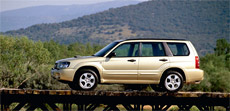 Forester gearboxes are both mechanical and automatic. Cancellation problems arise quite rarely, but there are not enough machines with automata that even a working unit can work abruptly, so these boxes still do not like to break down (in particular, when the car is stubbornly): sometimes gearboxes and the gearboxes and differentials are broken.
Forester gearboxes are both mechanical and automatic. Cancellation problems arise quite rarely, but there are not enough machines with automata that even a working unit can work abruptly, so these boxes still do not like to break down (in particular, when the car is stubbornly): sometimes gearboxes and the gearboxes and differentials are broken. The suspension cannot be called a short-lived, its elements are generally quite strong, except for struts of transverse stability stabilizers: they fly out at once. The brakes of simple Forester have a normal resource, but the turbuls running the parts are wear out very quickly (the same STIs may require the replacement of the pads before the end of the interservice interval, and they are quite expensive: even for ordinary versions, the original front pads will cost 4 thousand rubles. .).
Despite the impressive list of problems, it would be unjustly to call this car. Suffice it to say that many copies are killed in Japan (this concerns right-handed models, there are many in our country), because even there they did not buy them in order to ride each other, rice. Pay for the sins of the previous owners had to already have our customers. I must say, Russian drivers are also not sugar: everyone knows how we care for cars. And if even durable cars, when they do not regret, quickly come into the deplorable state, what happens to such a complex and capricious parquetnik, like Forester? However, despite the minor drawbacks, he still combines many positive features: practicality, ease of use, quality, and some versions of amazing running properties. It turns out, not in vain deserved the title of almost a cult car.
Approximate prices in Moscow: from 250 (Forester SF with engine 2 l 1998 release) to 900 thousand rubles. (Forester SG with a 2.5 liter of the year 2007 release).
Advantages and disadvantages of the model
Advantages
Excellent dynamics (from turbouths), convenient to use salon, four-wheel drive in each car
disadvantages
Calm dynamics (near ordinary versions), a slightly close salon
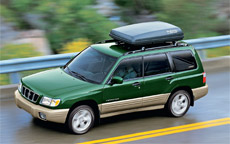
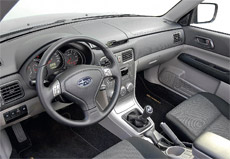
A source: Magazine cars and prices June 22, 2009.
Video Test Drives Subaru Forester since 2008
Video crash tests Subaru Forester since 2008
Test drives Subaru Forester since 2008
Crash test Subaru Forester since 2008
Crash Test: Details91%
Driver and passengers
73%
Pedestrians
91%
Children-passengers
86%
Active security system


